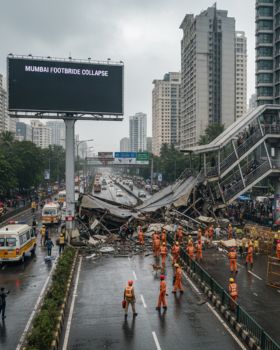Disclaimer
This blog is for informational purposes only and does not constitute legal, safety, or professional advice. References to the University of Chicago incident are based on publicly available reports, and no fault or liability is implied. Readers should consult qualified professionals for guidance on workplace safety, compliance, or contractor management solutions.
What Happened and Why It Matters
In June 2024, the University of Chicago accident became a headline across the nation. Two workers fell more than 80 feet while working on a hospital’s planned cancer pavilion. Tragically, one worker lost his life, and the other sustained critical injuries. A lawsuit soon followed, alleging that the scaffold was “incredibly deficient,” highlighting concerns about accountability and compliance.
This wasn’t an isolated incident. Across the United States, falls remain the leading cause of fatalities on worksites. OSHA reports that improper scaffolding and failure to follow safety standards rank among the top citations issued year after year. A scaffold failure accident is not just a tragedy—it’s a preventable event that exposes deeper issues in how projects are managed and monitored.
Such incidents remind us that workplace safety isn’t only about regulations on paper; it’s about ensuring that teams, contractors, and subcontractors are aligned, trained, and properly equipped. Understanding the importance of safety protocols and digital oversight is essential if companies are to avoid repeating similar tragedies.
How Do You Manage Safety and Compliance?
Managing risks like the one that occurred in Chicago requires a holistic approach. Traditional methods—manual checklists, paper reports, and reactive inspections—are often too slow to catch hazards before they become accidents. This incident showed how even large, high-profile projects can face gaps in oversight if safety measures are not actively monitored.
So, how do you manage risks like OSHA safety violations effectively? The answer lies in consistent monitoring, better communication, and data-driven decision-making.
- Proactive Safety Inspections
Scaffolds and equipment must undergo routine inspections not only when projects begin but also during the work itself. A weak joint or missing guardrail may seem minor until it results in a fall that changes lives forever. - Real-Time Reporting Systems
Hazards cannot wait to be discovered days later in paperwork. Digital reporting platforms allow supervisors to log issues instantly and trigger corrective actions before accidents escalate. - Compliance Tracking
OSHA regulations exist for a reason. Keeping track of every safety measure, every inspection date, and every violation is essential. Without this discipline, even well-intentioned contractors risk penalties, lawsuits, and worse—human lives. - Training and Accountability
Safety management isn’t just about hardware; it’s about people. Workers need ongoing training, clear guidance, and leadership accountability. If risks are overlooked, similar scaffold-related tragedies can occur on construction projects.
Better systems and technology could help prevent these lapses. The challenge is creating one source of truth where all stakeholders—owners, contractors, and regulators—can align on safety.
Why a Contractor Management Portal is the Best Way Forward
Accidents like the worker death Chicago highlight that safety is not only a regulatory checkbox but a business imperative. Delays, lawsuits, and reputational damage follow tragedies, leaving companies scrambling for solutions they should have implemented earlier.
This is where a Contractor management portal becomes essential. Unlike manual or fragmented systems, a centralized platform ensures that safety data, compliance records, and contractor activities are integrated in real-time. For projects as complex as hospital expansions or urban developments, this level of oversight can make the difference between a safe day on site and a preventable tragedy.
Key benefits of using the best contractor management software include:
- Real-Time Compliance Monitoring: Automatic alerts when safety inspections are overdue or when OSHA standards are at risk of being breached.
- Centralized Safety Records: Digital logs of scaffolding inspections, worker certifications, and incident reports—accessible at any time.
- Improved Communication: Contractors, subcontractors, and project owners stay aligned through one portal, minimizing confusion.
- Risk Reduction: By identifying hazards early, the likelihood of scaffold failure accident scenarios drops dramatically.
- Legal and Financial Protection: Stronger documentation means companies are better prepared in case of disputes, lawsuits, or regulatory inquiries.
What sets a contractor management portal apart is its ability to transform safety from a reactive process into a proactive strategy. Instead of waiting for accidents to highlight gaps, teams can use real-time insights to keep projects compliant and workers protected.
Looking back at this incident, it is evident that scaffold accidents often involve more than just a fall—they can point to gaps in oversight and systems. With digital platforms, project leaders gain the transparency and control they need to prevent history from repeating itself.
Final Thoughts
The fatal fall site at the University of Chicago is a sobering reminder of what’s at stake on every project. Safety failures don’t just result in fines or project delays—they change lives forever. By learning from these tragedies, organizations can strengthen their systems, prioritize compliance, and embrace technology that could help prevent future accidents.
Investing in modern tools like a Contractor management portal or the best contractor management software is not just about efficiency—it’s about responsibility. It’s about ensuring that every worker who steps onto a scaffold or into a work zone can go home safely at the end of the day.
📞 Contact Us:
USA: +1 (941) 337-1671
Ireland: (+353) 21 4536034
UK: (+44) 800 8021092
🚀 Learn how SHEQ Network can support safer workflows!
📧 info@sheqnetwork.com
🔗 Learn more at sheqnetwork.com
📅 Ready for a personalized demo? Book your session here!






